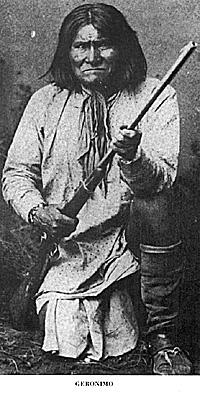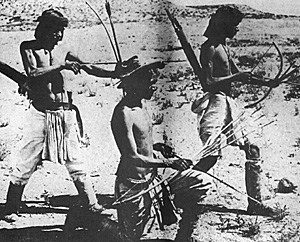The Roots of Conflict
 At right: Geronimo
At right: Geronimo
The Apache were a distinctive culture in their own right, a mixture of the peoples of the Great Plains, the South-West, and the Great Basin. There were six true Apache tribes, of which three were to come into direct conflict with the white man. One of these were the Mescalero, of South-East New Mexico, and Western Texas, centred around their natural fortress of the 12,000 foot-high Sierra Blanca. The next tribe, the Chiriuchua, were divided into three main bands. The eastern Chiriuchua, whose most famous sub-clan was the Mogollon Apache Geronimo's people; the central Chiruichna, also called the Cochise Apache, and the southern Chiriuchua. The first two groups lived in an area stretching from South East Arizona through New Mexico into Mexico. The third group had their territory in Northern Mexico.
The Apache population was always small, perhaps no more than 6-8,000 at its peak, and was spread thinly across the and lands which were its home. The Apache lived in small groups, with little tribal cohesion or centralised leadership. Loyalty was directed towards the local group, which might consist of 30 or so closely related extended families. Each group had its own leader, whose powers were again limited. He had to rely upon his powers of persuasion, his reputation for bravery and his generosity, if he were to get his way. Bands with capable leaders, such as Cochise and Victorio, might grow in strength and influence. Weak or unlucky leaders would find themselves deposed.
Apache life was governed by the harsh environment in which they lived. Little agriculture was practised, the clans living by hunting and foraging. Hunting was normally done either by lone warriors or in small groups. Camps were frequently moved around according to the availability of food.
 Apache warfare took two main forms. There was the raid, defined as being "to search out enemy property", and war, which was "to take death from an enemy", and included a large element of vengeance. Raids were usually mounted in order to replenish food supplies, and would be carried out by a dozen or so warriors, who aimed to avoid battle whenever possible. War was a much more serious affair, and a clan would call for assistance on its neighbouring kinsmen, so that a force of up to 300 warriors might be raised.
Apache warfare took two main forms. There was the raid, defined as being "to search out enemy property", and war, which was "to take death from an enemy", and included a large element of vengeance. Raids were usually mounted in order to replenish food supplies, and would be carried out by a dozen or so warriors, who aimed to avoid battle whenever possible. War was a much more serious affair, and a clan would call for assistance on its neighbouring kinsmen, so that a force of up to 300 warriors might be raised.
Apaches used stealth whenever possible; they preferred to attack simultaneously from several directions, often just before dawn when an enemy might be least prepared. Their style of fighting was intensely practical; Apache did not bother to count coup, preferring to concentrate on killing as many of the enemy as possible. They also tended to torture prisoners, though they rarely scalped their victims. A significant victory usually marked the end of a campaign.
Apache boys were trained and prepared for war from an early age. A young man would be expected to carry out four raids, on which he was the subject of various religious ceremonies, as well as having to carry out all the menial duties of the warband, before he would be formally accepted as an Apache warrior.
Qualities
The fighting qualities and endurance of the Apache fighting men were widely recognised by their opponents. It was General Crook who described them as "Tigers of the human race." Their dress was simple, consisting of a shirt, breech clout, and moccasins. Blankets were carried, together with a water jar and basic rations of dried meat. More ceremonial items of clothing, often with sacred associations, were sometimes worn. The Apache placed considerable value on the supposed supernatural abilities of leaders such as Geronimo, with his claimed invulnerability to hostile fire, and Lozen, sister to Victorio, a woman warrior who claimed to be able to detect the approach of an enemy through a tingling sensation in her palms. Weapons included bow, lance, club and knife, as well, increasingly, of rifle and bandolier of cartridges. Weapons were frequently blackened to aid camouflage, for the Apache were masters of concealment. During the wars with the Americans and Mexicans, regular troops were rarely able to penetrate the Apaches' natural strongholds without the assistance of native guides.
If pursued, an Apache warband would scatter, making use of caches of food which had been hidden with such an eventuality in mind. If opportunity arose, they would double back and ambush their pursuers. Though the Apache valued courage, they lacked the bravado of the Plains Indians, for they had not the manpower to be able to afford heavy losses.
War between the Apache and the Spaniards began in the 1540's, and continued for centuries, both sides displaying considerable cruelty. But by the end of the 18th century, the situation had begun to calm down, as the Apache, persuaded by generous subsidies, began to settle on reservations. With Mexican independence, these subsidies came to an end, and raiding resumed, leading to full-scale and bitter war between the Mexicans and the Mimbrenos Apache led by Mangas Colorados.
After they gained control of the former Spanish South-West, in 1848, the United States became embroiled in the Apache troubles, and the tension was heightened when gold was discovered in California in 1849. This brought a flood of new settlers to the area, and, although the Apache initially reacted cautiously, friction soon developed leading to incidents such as the one in which Mangas Colorados was tied to a tree by some miners and flogged, triggering his unrelenting hostility to all of the whites.
First Clashes
The first clashes between the Apache and the U.S Army came in 1861, in skirmishing between Cochise of the central Chiruchua and the regulars, but the outbreak of the Civil War resulted in most of the latter being withdrawn, and for a few years the South-West lay open to the devastating raids of Mangas Colorados and Cochise.
But in 1862, General James Carlton's California Volunteers reconquered Arizona and New Mexico from the Confederacy, and took on the Apache as well. Cochise was briefly captured, and some of his family hanged, whilst in 1862 Mangas Colorados was wounded in a skirmish at Apache Pass. His men however, took him to the nearby town of Janos and informed the doctors there that the town would be burnt unless their leader was cured. His escape was only a brief one however, for in the following year Mangas was captured whilst under a flag of truce, and shot "while attempting to escape."
The fight went on, the Apache led by such warriors as Victorio, Nana and Cochise, but the end of the Civil War meant that the Government could give increased atten'tion to the troubled South-West.
More Tigers of the Human Race
Back to Colonial Conquest Issue 8 Table of Contents
Back to Colonial Conquest List of Issues
Back to MagWeb Master List of Magazines
© Copyright 1996 by Partizan Press.
This article appears in MagWeb (Magazine Web) on the Internet World Wide Web.
Other military history articles and gaming articles are available at http://www.magweb.com